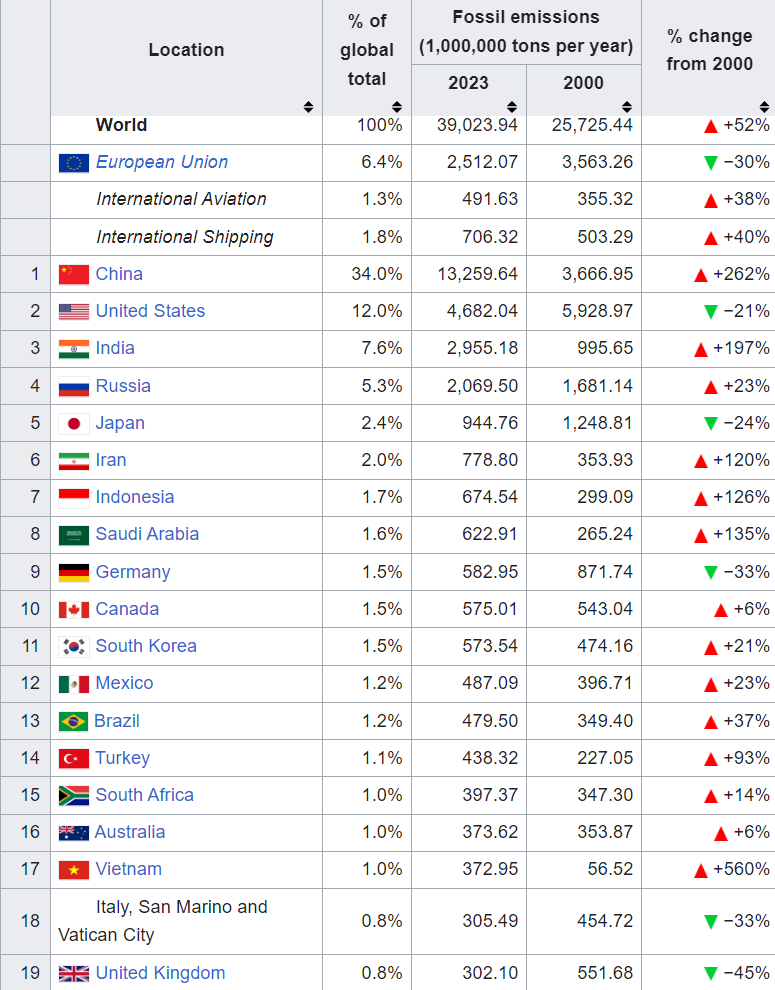
Either Way – It’s A Call to Action for a Sustainable Future
Climate change or climate crisis is one of the most divergent discussions, with polar viewpoints. Science says global warming and extreme weather patterns are the result of an increase in atmospheric CO2, but science also says the rise in our planets temperature due to sun cycles are causing a rise in CO2. Both viewpoints are hotly debated, but we must bear in mind that science is never settled.
‘Science’ – Any system of knowledge that is concerned with the physical world and its phenomena, and that entails unbiased observations, systematic experimentation and constant questioning.
Whichever your point of view this article is not to open a debate on conflicting approaches, but consequences of climate change are already being felt across the globe – that fact is not in question. Primarily in the form of extreme weather events, the impacts of climate change are reshaping our world, but amidst this disruption lies an opportunity to transform our world sustainably and equitably. This article examines the complexities of climate change, explores potential future scenarios and outlines actionable strategies to mitigate its effects.
PreEmpt’s ‘Climate Change or Climate Crisis?’ strategic research document (free access to everyone) gives you options with actionable steps. But let’s examine some details:
The Urgency of Climate Change
Climate science presents multiple perspectives on global temperature changes. Data shows that since the Industrial Revolution, both atmospheric CO2 levels and global temperatures have increased. Some researchers attribute these changes primarily to human activities, particularly the burning of fossil fuels, while others point to natural climate cycles and solar activity as potential primary drivers.
Temperature measurements indicate a rise of approximately 1.1°C above pre-industrial levels. Organizations like the IPCC project potential further increases, though there are varying interpretations of these trends and their implications. Current climate models suggest different scenarios for future temperature changes.
Environmental observations show shifts in weather patterns, including changes in the frequency of heatwaves, droughts and storms. Some coastal areas are experiencing changes in sea levels, both up and down, while various ecosystems are undergoing adaptations to shifting conditions. These changes have impacts on human communities and wildlife. There are concerns of loss of certain species due to changes in habitat, but also note the greater proliferation of plant life due to the increase in CO2 levels.
Future Scenarios: Pathways to a Sustainable World
To address the climate change, we must envision and work towards a sustainable future. These models outline several alternative futures, each with its own set of consequences, objectives and challenges.
1. Green Resilience 2040
Green Resilience 2040 envisions a world where the global economy has transitioned to a sustainable, net-zero model by 2040. Several governments though are aiming for 2050 as a more likely date for adoption. However, this scenario emphasizes the adoption of clean technologies, the scaling of renewable energy and the development of a circular economy. The transition to a green economy would stimulate job creation, encourage innovation, and enhance energy security. However, it would also require a massive workforce transition and significant financial investment.
Upsides:
- Reducing greenhouse gas emissions.
- Enhancing energy security by reducing dependence on fossil fuels.
- Fostering sustainable development and creating green jobs.
Downsides:
- Potential job displacement in traditional industries, such as coal and oil.
- High transition costs and the need for substantial financial flows.
- Resistance from fossil fuel-dependent sectors and industries.
Likely Impact: High
Likelihood: Moderate
2. AI Governance 2030
AI Governance 2030 explores the role of artificial intelligence (AI) in accelerating climate action. In this scenario, AI is integrated into governance structures to improve decision-making, optimize resource allocation and streamline operations. AI-driven systems could help public organizations achieve climate targets more efficiently and effectively. However, this future also raises concerns about data security, privacy and the socio-ethical implications of AI.
Upsides:
- Data-driven policy formulation and enhanced public service delivery.
- Efficient climatic interventions (not yet proven) and optimized resource allocation.
- Accelerated global climate action through AI-powered solutions.
Downsides:
- Concerns over data security and privacy breaches.
- Potential job losses due to automation and AI-driven processes.
- Socio-ethical implications of AI in governance and decision-making.
Likely Impact: High
Likelihood: High
3. Global Climate Pact 2030
Global Climate Pact 2030 envisions a robust international agreement that commits countries to aggressive climate targets. This scenario emphasizes the importance of global cooperation, technology sharing and mutual support in achieving climate goals. A global climate pact could accelerate climate action, facilitate technological breakthroughs and pool resources more effectively. However, it also hinges on diplomatic consensus and mutual compliance, which could be challenging to achieve.
Upsides:
- Faster global climate action through international collaboration.
- Shared technological breakthroughs and greater resource pooling.
- Enhanced global cooperation and mutual support.
Downsides:
- Risk of non-compliance by countries and geopolitical tensions – emissions from China and India in particular.
- Economic disparities and challenges in resource sharing.
- Dependence on diplomatic consensus and mutual trust.
Likely Impact: High
Likelihood: Moderate
4. Cognitive Arms Race 2040
Cognitive Arms Race 2040 represents a dystopian future where an unfettered AI race exacerbates social and climate change issues. In this scenario, the focus on competitive AI development diverts resources and attention away from global crises, such as climate change. The consequences could include social unrest, geopolitical tension and a failure to address the climate change effectively.
Upsides:
- Preserves global cooperation and prevents social disruption.
- Maintains focus on climate change.
Downsides:
- Restricts competition in AI development and may slow technological progress.
- Risk of monopolization of resources and power for AI development.
Likely Impact: High
Likelihood: High
Strategies for a Sustainable Future
To navigate the complexities of climate change and achieve a sustainable future, we must adopt a multifaceted approach that combines innovation, collaboration, and systemic thinking. The document outlines a proposed strategy for Green Resilience 2040, which serves as a blueprint for transformative action.
1. Accelerate Green Innovation
Fostering research and development of clean technologies is crucial for achieving a net-zero world. The goal is to ensure that solar energy powers 60% of global consumption by 2040. This requires significant investment in renewable energy technologies, energy storage solutions and energy efficiency measures.
2. Promote Cross-Sector Collaboration
Collaboration between corporations, governments, non-profits and communities is essential for developing holistic solutions to climate change. The target is to establish at least 50 global collaborative initiatives by 2035, focusing on renewable energy, clean tech and sustainable practices.
3. Finance for Sustainability
Channelling investment towards sustainable enterprises and technologies is pivotal for transitioning from carbon-intensive to green sectors. The aim is to ensure that 50% of global investment funds are ESG-compliant (Environmental, Social, and Governance) by 2037. This requires setting clear benchmarks, reassessing investment priorities and incentivizing green investments.
4. Mitigate Job Displacement
The transition to a green economy may result in job displacement in high-carbon sectors. To address this, it is essential to train, educate, and transition workers to emerging green markets. The goal is to transition 50% of the workforce from high-carbon sectors to clean sectors by 2027, minimizing socio-economic disruptions and fostering social equity.
5. Reduce Carbon Footprint through Legislation
Governments must introduce policies mandating a measured decrease in greenhouse gas emissions annually. The target is to achieve a 60% reduction in emissions from 2022 levels by 2030. This requires rapid implementation of carbon-neutral technologies and practices, supported by robust legislation and enforcement mechanisms, and whole-world agreements that can be monitored and policed – easier said than done.
Recommendations for Immediate Action
The document provides several key recommendations for addressing climate change, which can be summarized as follows:
- Adopt Meta-Intelligence (MI) in Governance: Integrate AI into policy decision-making to predict climate scenarios, assess policy impacts and plan interventions. Target the deployment of MI systems in 60% of policy-making bodies by 2026.
- Elevate Sustainability Finance: Increase financial flows to develop and implement essential sustainable technologies. Aim to double current financial allotments for sustainability innovations by 2025.
- Promote Transnational Eco-Collaborations: Establish multinational collaborations focused on renewable energy, clean tech, and sustainable practices. Aim to establish at least five new multinational collaborations each year.
- Mitigate Job Displacement from Clean Innovations: Train and transition workers from high-carbon sectors to emerging green markets. Target transitioning 50% of the workforce to clean sectors by 2027.
- Reduce Carbon Footprint through Legislation: Introduce policies mandating a measured decrease in greenhouse gas emissions annually. Aim for a 60% reduction in emissions from 2022 levels by 2030. This may be possible in western countries, but there is much work to do in other countries, as can be seen in the table below:
List Of Countries By Carbon Emissions

A Shared Responsibility
Climate change is an existential threat that demands immediate and transformative action. The future is uncertain, but the choices we make today will shape the world we leave for future generations. By adopting innovative solutions, fostering global cooperation and prioritizing sustainability, we can mitigate the impacts of climate change and build a resilient, equitable world.
The time to act is now. We must embrace our shared responsibility for Earth’s preservation and work together to create a future defined by harmony between technology and nature, progress and preservation and humanity’s aspirations with Earth’s resilience.
Ready to navigate the complexities of climate change and make informed, strategic decisions for a sustainable future?
At PreEmpt.Life, we lead the world in decision intelligence, strategic foresight and horizon-scanning services. Let us help you stay ahead of the curve and drive transformative change. Contact us today to learn more about how we can support your journey towards a sustainable future.
